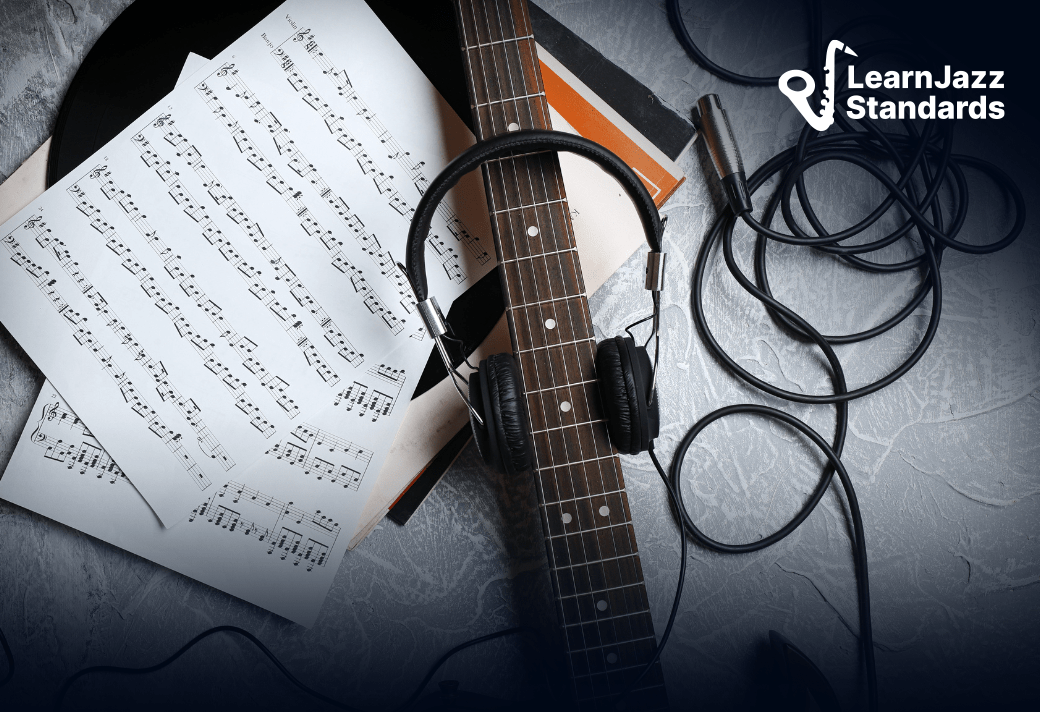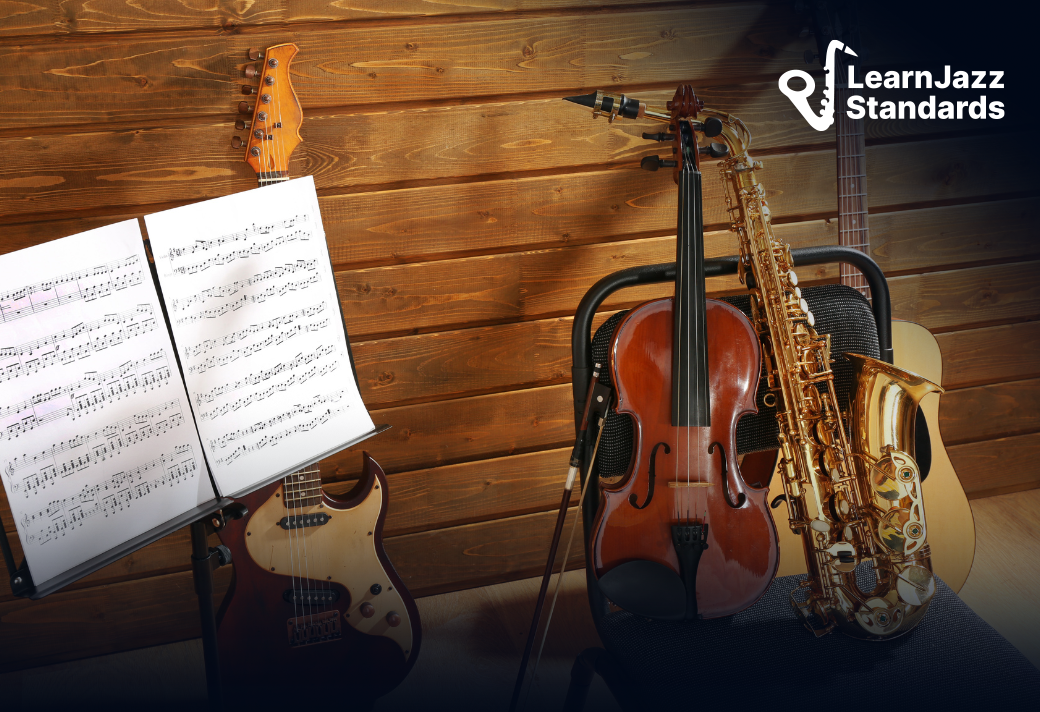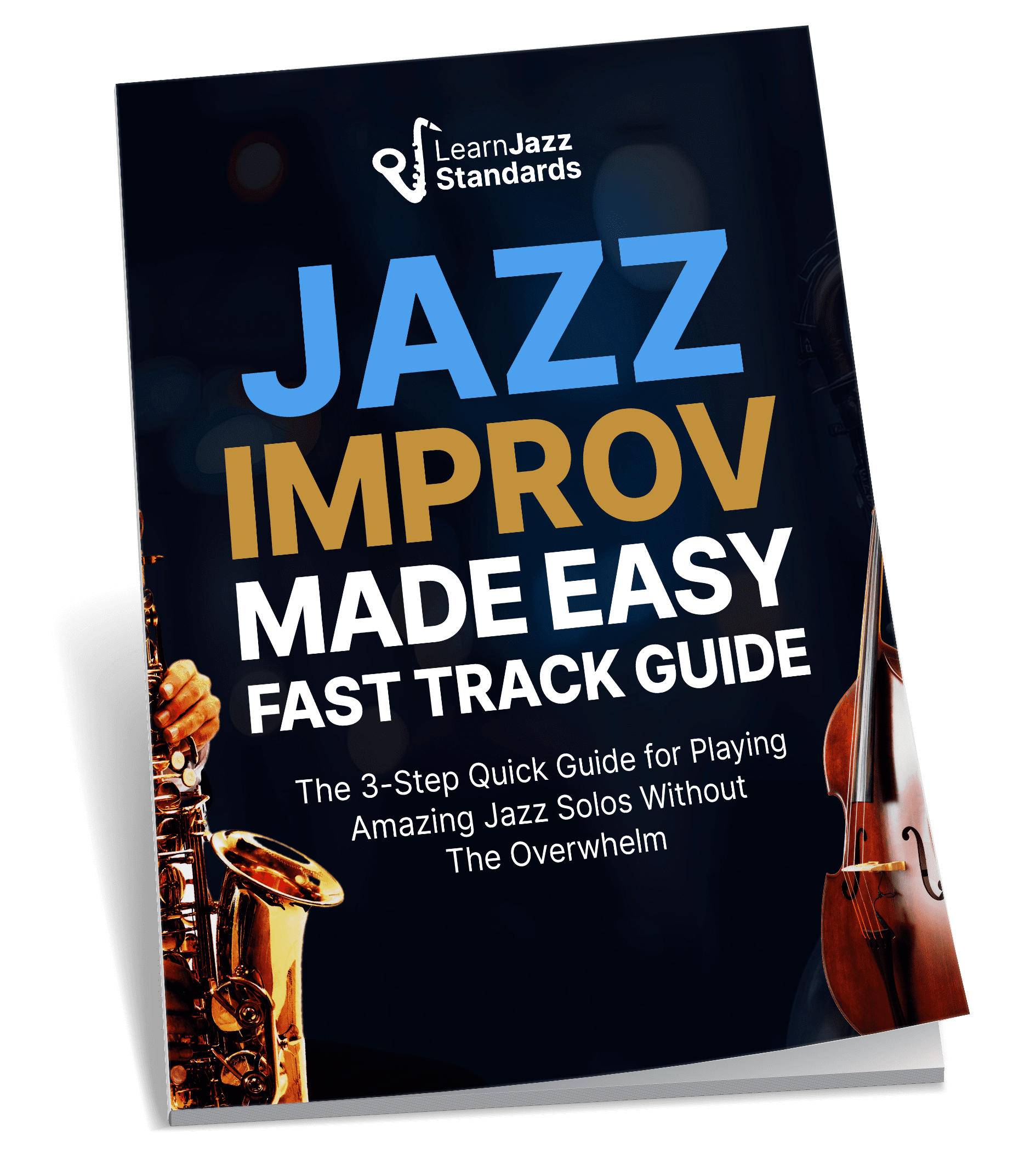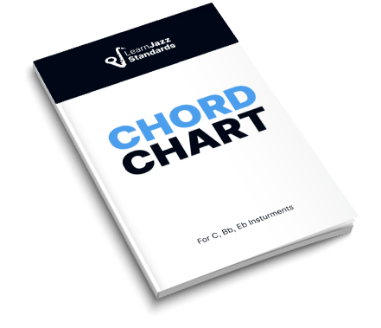The 2-5-1 chord progression is the most common (and maybe most important) harmonic building block used in jazz standards. Knowing what ii-V-I chord progressions are, how to identify them, and how to improvise over them are essential to studying jazz!
Luckily, we will do a deep dive into the ii-V-I chord progression so that you’ll come away from this article with everything you need to understand, identify, and improvise over this essential chord progression.
We will also review common substitutions jazz musicians use in place of 2-5-1 progressions to add variety, tension, and altered sounds to their chord comping.
Whether you play jazz piano, jazz guitar, or a non-chordal instrument, you’ll need to know how chord progressions work to truly understand harmonic and improvisational concepts.
If you want to dive deeper into the 2-5-1 chord progression, then you need to check out the Learn Jazz Standards Inner Circle.
The Inner Circle helps musicians master all the key elements of jazz, from music theory to improvisation. With instrument-specific courses, jazz theory and improvisation workshops, invaluable masterclasses, and a full library of jazz standard deep dives updated monthly…
…You’ll have everything you need to take your jazz playing to the next level!
Come see what the Inner Circle has to offer.
Table of Contents
Understanding Scale Degrees, Keys, and Diatonic Chords!
Before diving into ii-V-Is, let’s take a moment to refresh scale degrees, diatonic chords in major and minor keys, and the Roman numerals we use to label and identify them. This will help us set the foundation for understanding chord progressions later on.
If you are already familiar with these concepts, please use the table of contents to skip to later sections!
Understanding Major Scale Degrees
Each note in the major scale has a name and associated number. These names and numbers help us understand the function of each note in relationship to the parent key.
Here are the notes in the C major scale labeled with their Roman numeral and their scale degree names:
- vii° Leading Tone (B)
- VI. Submediant (A)
- V. Dominant (G)
- IV. Subdominant (F)
- iii. Mediant (E)
- ii. Supertonic (D)
- I. Tonic (C)

Understanding Minor Scale Degrees
C major and A minor are relative major and minor keys. The notes and chords in the key of C major are the same as those in the key of A minor.
The difference lies in what note gets counted as the tonic.
Additionally, the seventh scale degree in minor keys is not called the leading tone. Rather, it is the Subtonic. Otherwise, everything is the same.
- VII. Subtonic (G)
- VI. Submediant (F)
- v. Dominant (E)
- iv. Subdominant (D)
- I. Mediant (C)
- ii°. Supertonic (B)
- i. Tonic (A)

Comparing Major Scale Degrees and Minor Scale Degrees
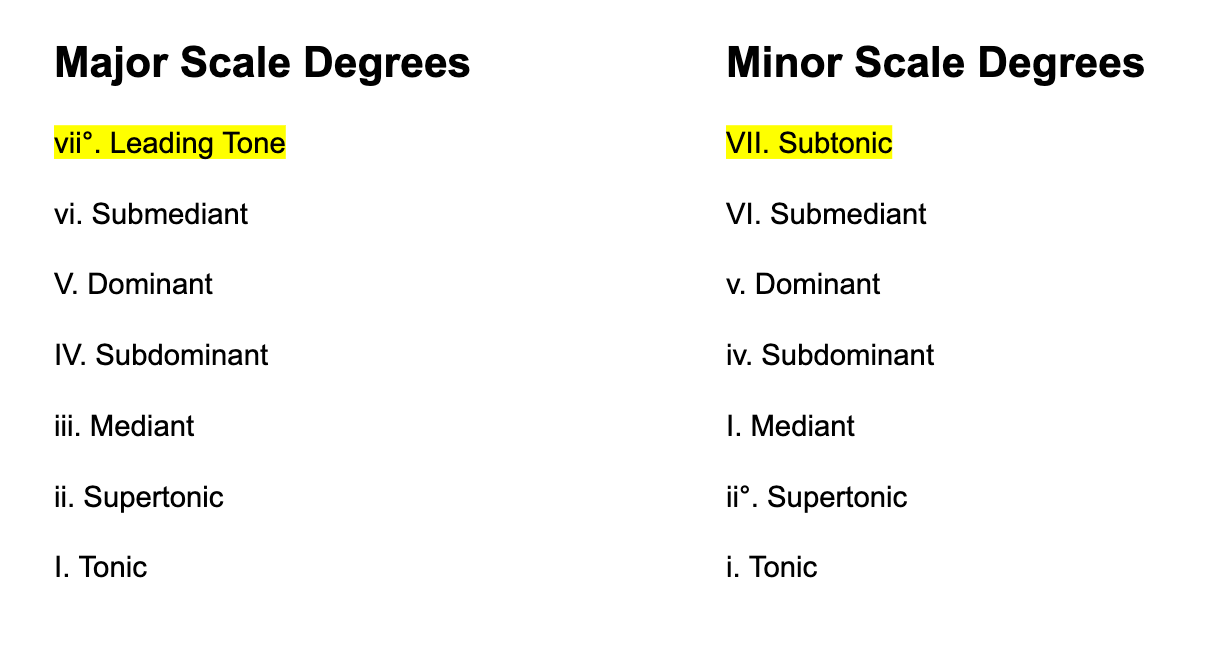
Building Diatonic Chords From Major and Minor Scales
Diatonic chords in major and minor keys are built from the scale degrees of the major scale and the minor scale, respectively (though they are both the same scale sequence).
Chords in C Major
If we take a C major scale and stack a third and a fifth above each note in the scale, we’ll get all the diatonic chords (triads) in the key of C major. However, you can’t simply stack any third or fifth! You need to use the notes in the scale to construct your chords.
That’s what makes these chords diatonic chords.
Let’s start by building a C major triad. Triads are three-note chords that contain three pieces of musical information:
- Some Kind of Fifth: G (perfect fifth), Gb (diminished 5th), or G# (augmented fifth)
- Some Kind of Third: E (major third) or Eb (minor third)
- A Root: C
In the key of C, the major chord built from this note is called the tonic chord. It’s the “home base” of the key. (C chord, key of C—makes sense!). We then add a major third (E) and a perfect fifth (G):
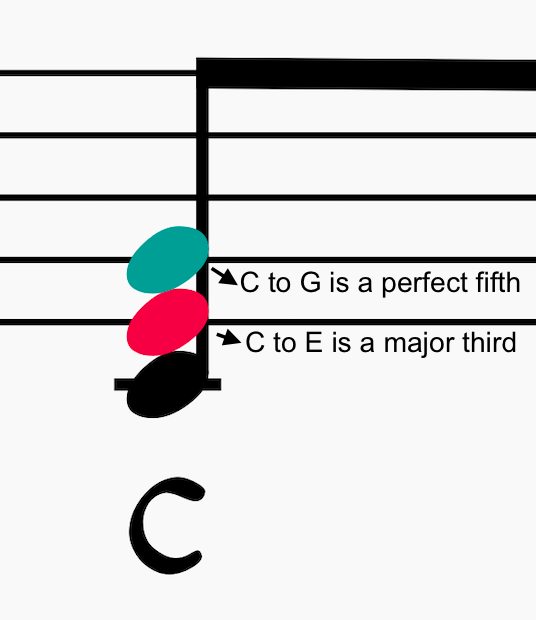
When we do this from every scale degree in C major, we get all C major diatonic chords:

- vii° chord, or a diminished chord built off the Leading Tone
- vi chord, or a minor chord built off the Submediant
- V Chord, or a major chord built off the Dominant
- VI Chord, or a major chord built off the Subdominant
- iii Chord, or a minor chord built off the Mediant
- ii Chord, or a minor chord built off the Supertonic
- I Chord, or the Tonic Chord
Chords in A minor:
Let’s do the same with the chords in A minor, starting with an A minor chord. To build our A minor chord, we’ll need a minor third (C) and a perfect fifth (E):
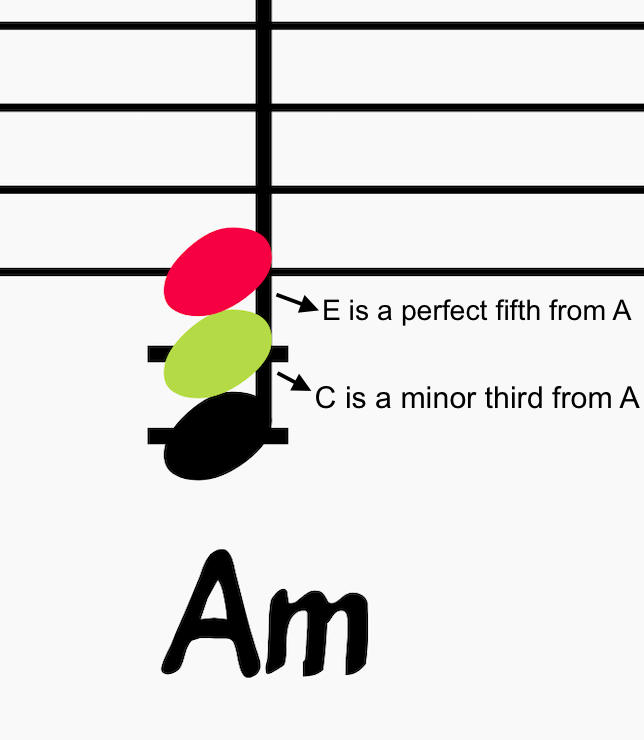
When we do this with all the scale degrees, we get all the diatonic chords in A minor:

- VIII chord, or a major chord built off the Subtonic
- VI chord, or a major chord built off the Submediant
- v Chord, or a minor chord built off the Dominant
- vi Chord, or a minor chord built off the Subdominant
- III Chord, or a major chord built off the Mediant
- ii° Chord, or a diminished chord built off the Supertonic
- i Chord, or the Tonic Chord
*note that sometimes the v chord in minor keys is replaced with a V chord (major triad instead of a minor triad). This change gives the V-i cadence more tension and weight and exhibits stronger voice leading.
Check out these articles for more on major triads, minor triads, and diminished triads.
Understanding the Roman Numeral System
Musicians use Roman numerals to express any chord from a particular key quickly. Major chords are labeled with capital Roman numerals, and minor chords are labeled with lowercase numerals. The numbers you see correlate to the chord you’d build from a particular scale degree.
If you know the key, you should be able to look at any chord progression written in Roman numerals and play it.
Finally… The 2-5-1 Chord Progression
This finally brings us to the focus of this article—2-5-1 progressions, or ii-V-I progressions!

The 2-5-1 chord progression above lets you know the harmonic function of each chord in the progression. This chord progression starts on the ii chord, moves to the V chord, and then resolves to the I chord.
This is the essence of the chord progression.
In the key of C, you’d start on a D- chord, move to a G chord, and resolve to a C chord.
- ii chord = D-
- V chord = G
- I chord = C

In the key of F, you’d start on a G- chord, move to a C chord, and resolve to an F chord.
- ii chord = G-
- V chord = C
- I chord = F

In the key of Bb, you’d start on a C- chord, move to an F chord, and then resolve to Bb.
- ii chord = C-
- V chord = F
- I chord = Bb

Another Way to Think of ii-V-I Chord Progressions (The Key to Understanding Jazz Chord Progressions)
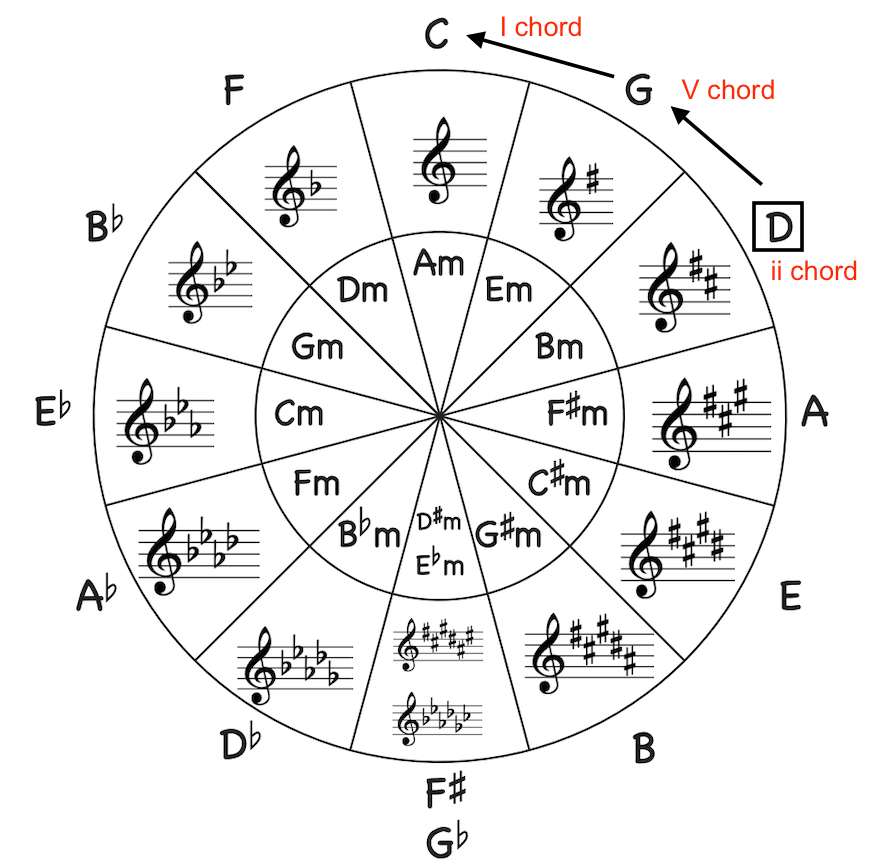
Jazz harmony is notorious for moving in fourths.
The 2-5-1 progression is a perfect example of this concept. Pick any key on the circle of fifths as your starting point. In the image above, I chose D as the starting point.
If you move counterclockwise on the circle, you move in fourths instead of fifths (clockwise). If you start on D and move counterclockwise, you’ll hit G and C.
D to G to C = II-V-I (II because we are only looking at root notes)
Let’s try starting on a different key.
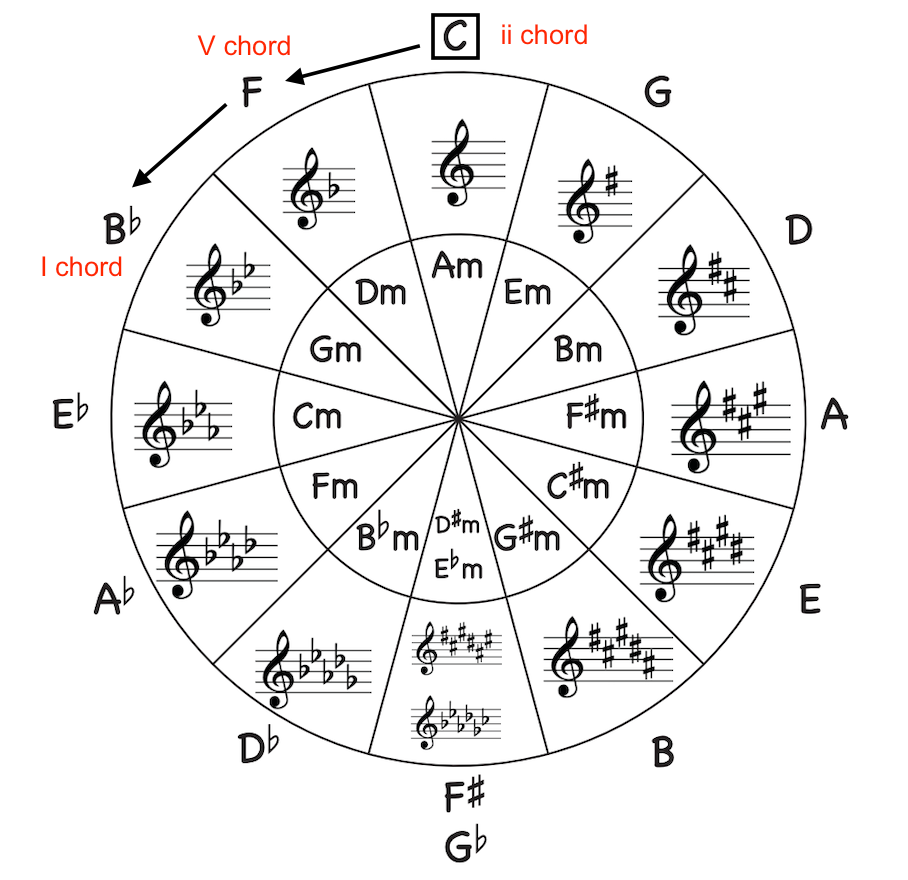
Here, I picked C as the starting point. If we move counterclockwise, we’ll land on F and end on Bb. Another II-V-I! The circle of fifths reveals the harmonic progression most commonly used in jazz.
The ii-V-I Chord Progression is the Basic Building Block of Jazz Harmony
This basic harmonic concept is all over jazz standards.
Let’s explore a few jazz standards to demonstrate:
Autumn Leaves
Here are the first four bars of Autumn Leaves in G- (Though I have them labeled as if they were in Bb because it makes it easier to analyze the function of the chords in the chord progression).

This four bar phrase moves in the circle of fourths, starting on C-, moving to F7, resolving to Bb, then moving an additional fourth to Eb.
Here is the chord progression for the first four bars of Autumn Leaves shown on the circle of 5ths:
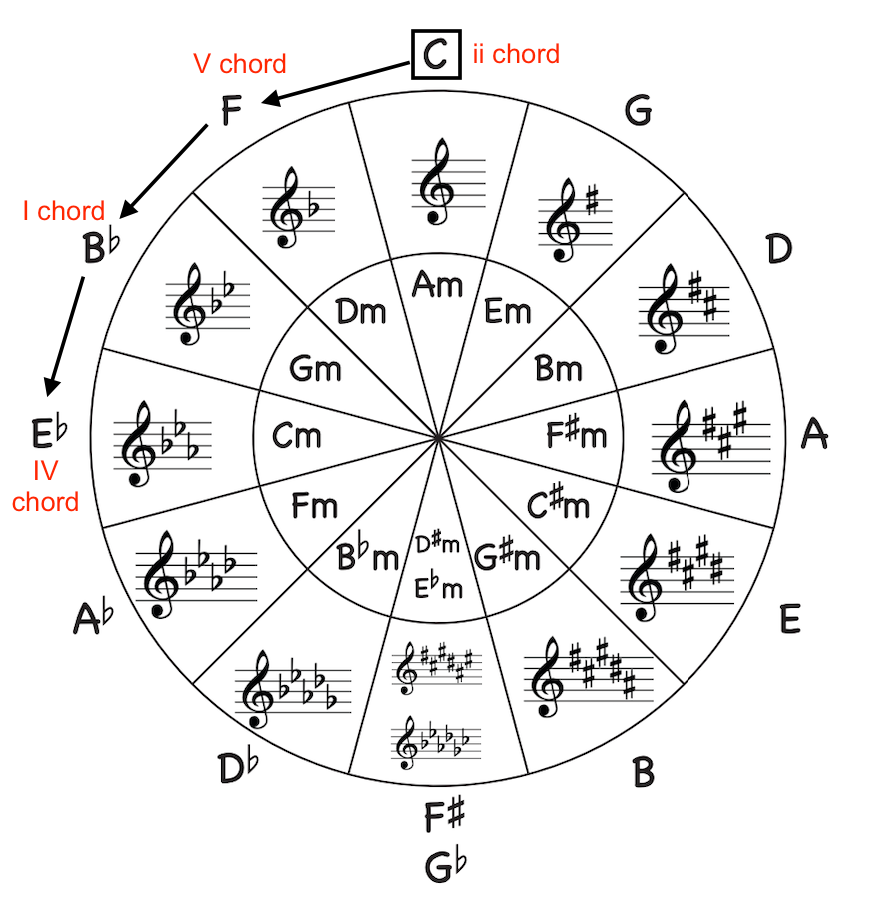
For more on Autumn Leaves, check out this article breaking down Autumn Leaves chords.
All The Things You Are
The jazz standard All The Things You Are moves in exactly the same way as Autumn Leaves. The root of each chord moves up in fourths until the third-to-last bar (root movement: F – Db). Then it resets to D and moves up in fourths to C.
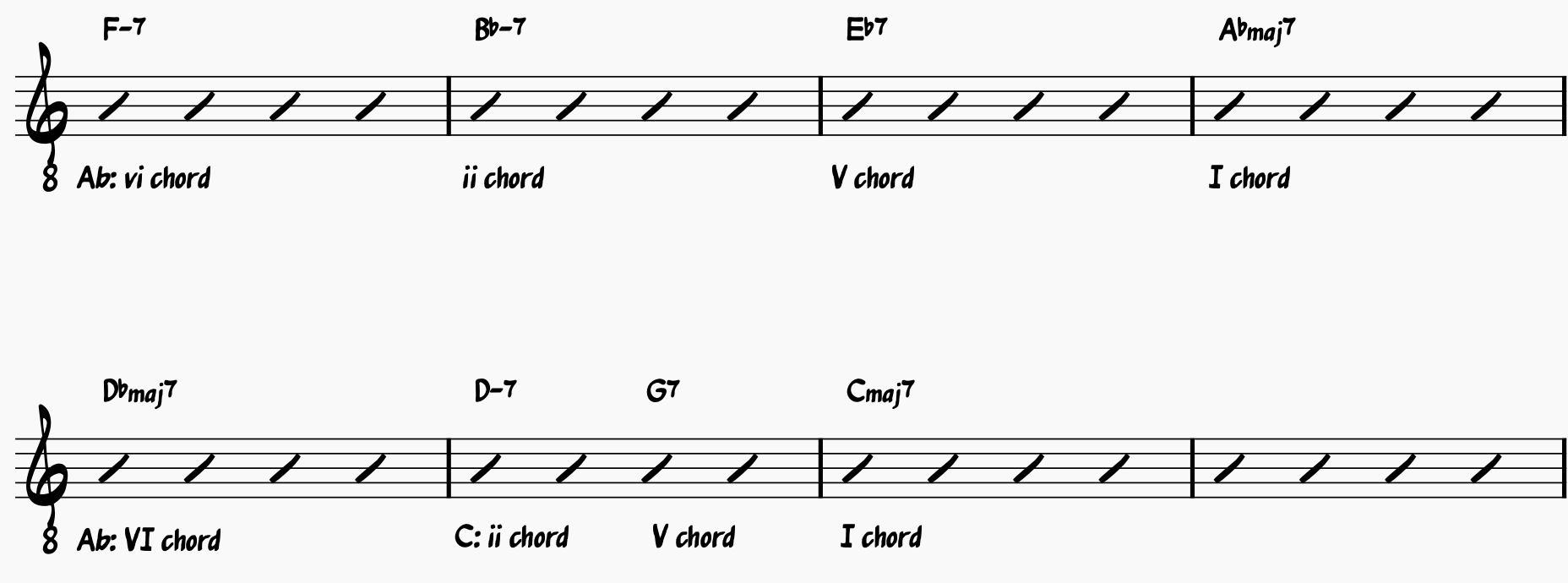
Here it is on the circle of 5ths, starting at F (F-) and resolving to Db. I’ve also included the last three bars, which contain a ii-V-I chord progression to C major.
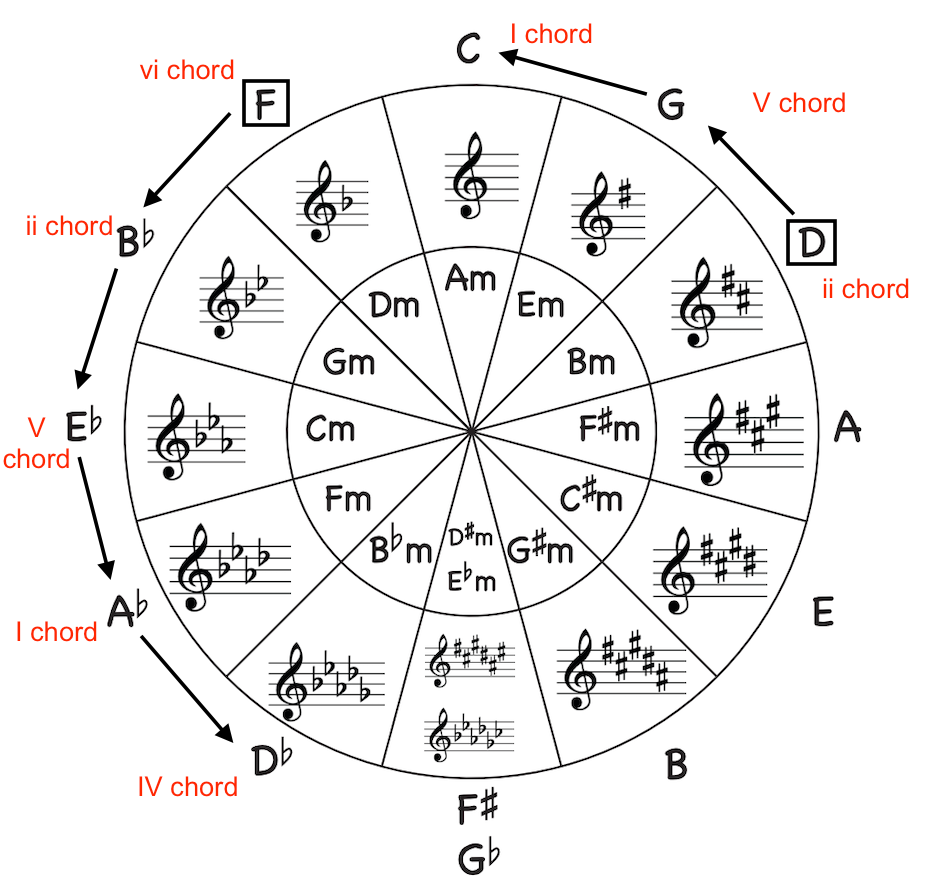
For more information, check out this harmonic analysis of All the Things You Are.
The Minor ii-V-i Chord Progression
2-5-1 chord progressions are not limited to major keys—they also work in minor keys. The principle is the same; however, the chord qualities change. Usually, a minor ii-V-i starts with a half-diminished chord for the ii. It then moves to an altered V chord before resolving to a minor chord.
Bars 5-8 of Autumn Leaves contain a basic example of a minor ii-V-i:

This is what that progression looks like on the circle of 5ths:
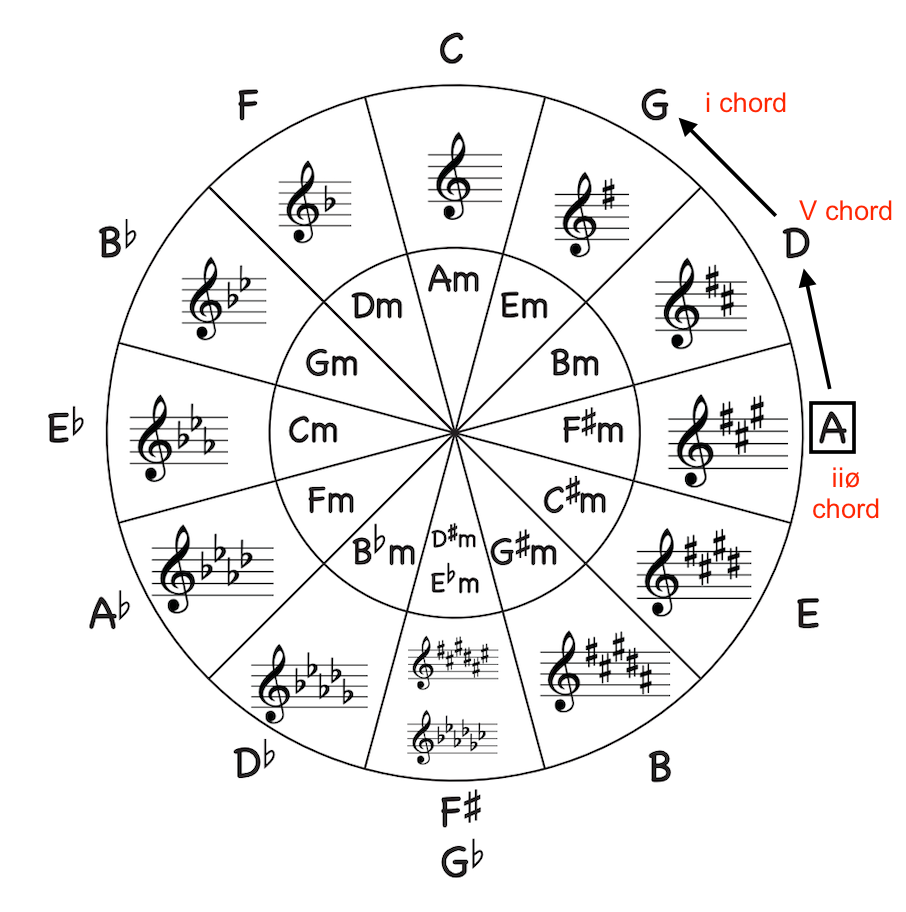
BEFORE YOU CONTINUE...
If music theory has always seemed confusing to you and you wish someone would make it feel simple, our free guide will help you unlock jazz theory secrets.

What’s Actually Happening in a ii-V-I Chord Progression
Now that we understand what 2-5-1 chord progressions are and why they are important in jazz music, let’s peer under the hood to discover what’s happening with the notes as we move through each chord.
Understanding how the chord tones change will help you better understand jazz harmony and make you a stronger improviser because you’ll know exactly what notes to target when playing over a 2-5-1 progression.
To start, let’s examine the notes in the ii chord, V chord, and I chord. We’ll use a ii-V-I chord progression in C major for this example.
Here is a root position 2-5-1 chord progression with the notes labeled:

However, the voice leading is less clear when the chords are in root position. Let’s change the inversion on the G7 chord to bring it closer to the D-7 and Cmaj7 chords.
In the following ii-V-I, we’ve brought the G and the B up an octave to create a 2nd inversion dominant seventh chord. This change in the chord voicing will help us illustrate how the chord tones move through the chord progression.

Guide Tones
Guide tones help guide the movement of notes through a chord progression. Technically, the guide tones are the 3rd and 7th of a chord, but any note in a chord can move with good voice leading.
Check out how each note moves (or doesn’t move) in our 2-5-1 progression:

ii – V
When the minor chord switches to the dominant chord, the C (7th of D-7) moves to B (3rd of G7), the A (5th of D-7) moves to G (root of G7), and the F (3rd of D-7 and 7th of G7) and D (root of D-7 and 5th of G7) stay the same.
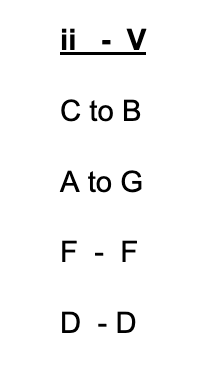
V – I
Then, when the dominant chord resolves to major, the B (3rd of G7 and 7th of Cmaj7) stays the same. The G (root of G7 and 5th of Cmaj7) also remains the same. The F (7th of G7) moves to E (3rd of Cmaj7), and the D (5th of G7) moves to C (root of Cmaj7).
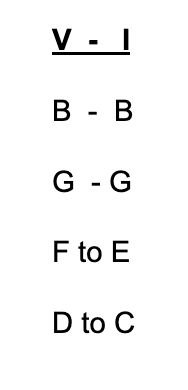
Shell-Voicings
Shell Voicings are three-note voicings with only a root, a 3rd, and a 7th. Forgetting about extensions for a moment, you only need these three notes to understand the harmonic movement in any chord progression.
- The root tells you where to place the chord in a key or tonal center
- The 3rd tells you whether the chord is major or minor
- The 7th tells you whether there is a major seventh interval or a minor seventh interval
The 5th isn’t always important when understanding voice leading in a progression. (However, there are instances where the 5th is very important because the chord is diminished or a half-diminished seventh chord).
Shell-Voicings In a ii-V-I Chord Progression:

Common 2-5-1 Chord Substitutions and Variations
Now that we understand 2-5-1 chord progressions, let’s break the rules like good jazz musicians and talk about common ii-V-I substitutions you’ll encounter in the wild. Some ii-V substitutions are written into jazz standards, while others are used by jazz musicians on the fly to add variety.
Here are some common ii-V-I chord progression substitutions and variations.
II7-V7-I
In this variation, the ii chord is replaced with a II7 chord. The jazz standard But Not For Me often opens with a II7 chord instead of a ii chord.
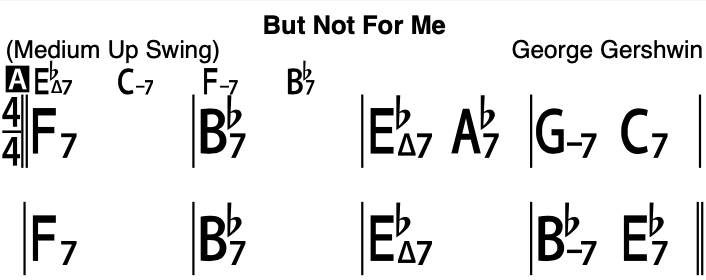
The dominant II sound is common in jazz tunes. The scale you’d use to improvise over it is called the Lydian Dominant scale, and it’s the fourth mode of the melodic minor scale!
For more on the melodic minor scale, check out our guide to the melodic minor modes.
iv-bVII-I
The iv-bVII is another ii-V substitution that jazz musicians use frequently. In another key, a iv-bVII is just another ii-V, but we label it according to where it resolves. It plays with the iv – I cadence and will probably be recognizable to you.
This variation is used in tunes like I Should Care:
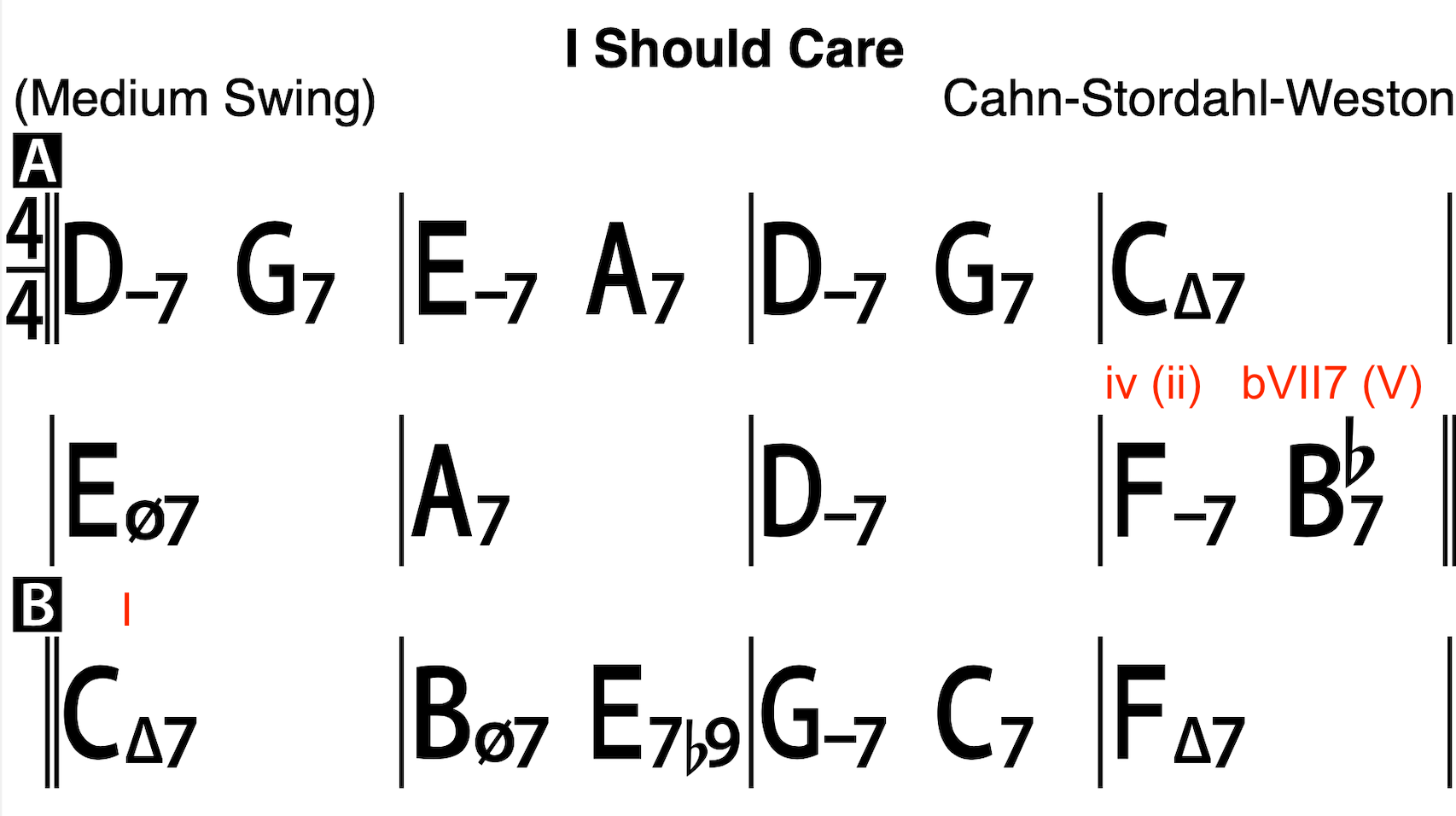
Mixed ii-Vs
It’s common for minor iiø-V chord progressions to resolve to major chords. This is another harmonic device written into many jazz tunes.
Here is one example from the jazz tune What Is This Thing Called Love:
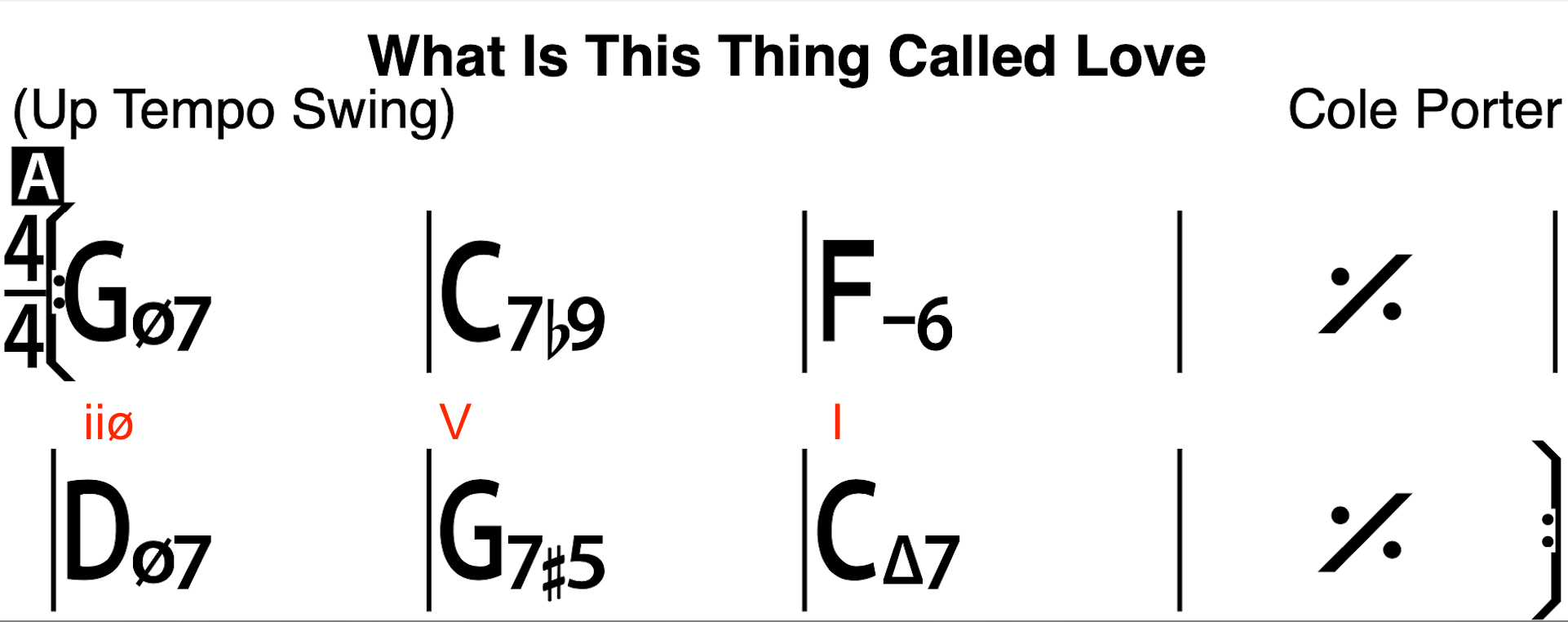
There are many other ways jazz musicians vary chord progressions. For more on chord substitutions and the infamous tritone substitution, check out these articles on tritone substitutions and chord substitutions.
Improvising Over 2-5-1 Chord Progressions
Now it’s time to improvise over ii-V-I chord progressions! Don’t fear—you now know exactly how these chord progressions function! You’ll be set if you place the guide tones on downbeats, outline the changes, and resolve to the tonic chord.
Here are some jazz improv tips to help keep you on track.
- Outline the Changes: Chord tones are your best friend—use arpeggios to outline the changes and place chord tones on the downbeats.
- Learn Bebop Scales and Elements of Jazz Vocabulary: From enclosure figures to chromatic approach tones, there are many elements of the jazz language that you’ll need to understand to speak the language well. Check out the 20 Jazz Licks link in the next section for a deep dive into the fundamentals of jazz language.
- Learn Jazz licks: Jazz licks help you get a practical handle on jazz vocabulary. Here is an article that will teach you 20 jazz licks. Also, check out our article on jazz guitar licks for even more licks. (Though the licks are played on guitar, most are jazz licks first and jazz guitar licks second.)
- Apply these concepts to real jazz standards!
Want To Master Jazz Chord Progressions Like The 2-5-1? Join the Inner Circle
If you want to take your jazz playing to the next level, learn jazz standards, and master jazz vocabulary, then check out the Learn Jazz Standards Inner Circle.
The Inner Circle Membership gives you access to over ten years of jazz education resources, from workshops and masterclasses to in-depth courses (even instrument-specific courses!) on every jazz topic.
Plus, you’ll gain access to our jazz standard library, where we have deep dives on many jazz standards (and add a new one each month!).
If you want to take your jazz chops to the next level, check out what the Inner Circle offers.

